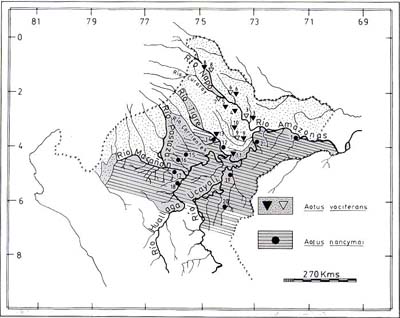

A total of 98 groups of A. nancymai were found in 245 km of transects. Of these, 75 groups were detected in 157 km of lowland forests, and 23 groups were detected in 88 km of highland forests (Table I). The overall densities were 11.3 groups/km 2 or 46.3 individuals/km 2 in lowland forests and 5.9 groups/km2 or 24.2 individuals/km2 in highland forests (Table III).
TABLE 1. Estimates of Population Densities for Aotus nancymai: Census by Transect
| Study areas |
Forest types
|
Groups/kM2
|
Individuals/kM2
|
| Nucuray |
Lowland
|
11.8
|
48.5
|
| Uritoyacu |
Lowland
|
13.2
|
54.2
|
| Pavayacu |
Lowland
|
11.7
|
48
|
| Chambira |
Lowland
|
10
|
41
|
| Yanayacu |
Lowland
|
9.7
|
39.8
|
| Maniti |
Highland
|
6.9
|
28.3
|
| Orosa |
Highland
|
6.6
|
27
|
| Cochiquinas |
Highland
|
3.9
|
16
|
| Tigre (right bank) |
Highland
|
6.4
|
26.2
|

TABLE II. Estimates of Population Densities for Aotus vociferans:
| Study areas |
Forest types
|
Groups/kM2
|
Individuals/kM2
|
| Lower Nanay |
Lowland
|
12.5
|
41.2
|
| Chambira |
Lowland
|
11.8
|
38.9
|
| Ampiyacu |
Lowland
|
5.9
|
19.6
|
| Pintoyacu |
Highland
|
3.2
|
10.6
|
| High Nanay |
Highland
|
0.6
|
2
|
| Apayacu |
Highland
|
3.5
|
11.5
|
| Tigre (left bank) |
Highland
|
2.2
|
7.3
|
TABLE III. Average Densities of Aotus nancymai and A. vociferans in Two Forest Types: Census by Transect
| Forest types |
Aotus nancymai
|
Aotus vociferans
|
||
|
Groups/km2
|
Individuals/km2
|
Groups/km 2
|
Individuals/km2
|
|
| Lowland |
11.3
|
46.3
|
10
|
33
|
| Highland |
5.9
|
24.2
|
2.4
|
7.9
|
Twentytwo groups of A. vociferans were found within the 56 km censused in lowland forests. Eleven groups were detected in the 128 km censused in highland forests (Table II). Overall densities were 10.0 groups/km2 or 33.0 individuals/km2 in lowland forest and 2.4 groups/km 2 or 7.9 individuals/km 2 in highland forests (Table III).
